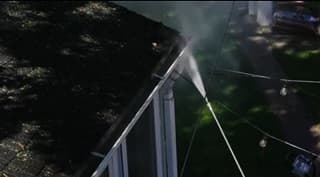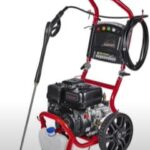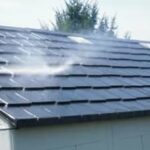As an Amazon Associate, this site earns commissions from qualifying purchases. For more information click here.
A pressure washer is a great tool when you need to do a lot of cleaning. Sometimes however it produces too much water, and in other cases too little. It can be frustrating for a beginner but no worries, as you can adjust the pressure on a pressure washer. There are different ways to do this and we will show how it is done.
Adjusting the unloader valve on a pressure washer allows you to increase or reduce water pressure. You can also use different nozzle tips to control both the water pressure and the spray angle. Some models also have an adjustable nozzle so you do not have to replace it.
Adjust Pressure on a Pressure Washer: 3 Ways
Knowing how to adjust pressure washer pressure is a must. If your car has not been cleaned in a while, high power is required. If you are using the pressure washer in the rain on the other hand, you may want to lower the pressure a little.
The following are the most common methods used to adjust pressure on a pressure washer. Depending on the model you have, one or more of these options may be available.
1. Twist the Wand Nozzle
Some pressure washers let you adjust the nozzle on the wand. Twist the nozzle and the water pressure increases or decreases. Narrowing the wand ups the pressure, while widening it reduces pressure. Being able to adjust without replacing the nozzle is convenient.
This is a nice feature and allows you to work continuously without needing to switch to a different nozzle. The amount of pressure you can change varies, with some units providing greater flexibility than others. The Teande 3200PSI Gas Pressure Washer makes this process quite easy.
2. Adjust the Valve
You can adjust the unloader valve and change the water pressure level the machine produces. Other models have the adjustment valve on its main body. Either way, changing the valve setting will alter the water pressure, its speed, the spray angle and force.
Some of the newer pressure washers no longer have the adjustment valve on its main body. There are two reasons: first it is inconvenient. If you are standing several feet away from the machine, you would have to walk back every time you needed to change the pressure.
Second, repeatedly adjusting the valve makes it susceptible to wear and tear. This is the reason why most manufacturers now opt for multiple spray nozzle tips. If your pressure washer comes with adjustable valves, it might require you to remove some nuts and bolts.
3. Replace the Spray Nozzle Tip
Any pressure washer you buy today typically includes at least four spray nozzles. There is no need to adjust the water pressure here. You simply replace the nozzle tip to suit your current task. If you need some nozzles for your pressure washer, the Tool Daily 5-Pack Nozzle Kit is recommended.
Here are the most common types of pressure washer nozzles. Note: red is rarely used in home cleaning due to the very high pressure.
| Nozzle Color | Pressure | Degrees | Used For | Not Intended For |
|---|---|---|---|---|
| Black | Very low | 60 | Applying soap, Rinsing Very light cleaning | Hard to remove stains and dirt |
| White | Minimal | 40 | Windows, Delicate surfaces | Stubborn dirt |
| Green | Light | 25 | Patios, Decks, Cars, Off-road vehicles, Most commonly used for homes | Hard to remove debris |
| Yellow | Medium | 15 | Prepping surfaces for paint, Mud on trucks, PVC mold | Soft surfaces |
| Red | Maximum | 0 | Rust or dirt on metal surfaces, For commercial and industrial use | Home use, Vehicles, Siding, Painted surfaces, Wood |
What Pressure Level Should I Use?
Pressure washer pressure in measured in PSI (pounds per square inch) . In simple terms it is the amount of force the water has. The level will depend on what you are cleaning. Applying too much pressure can damage the surface so you have to be careful.
GPM is gallons per minute. It is the volume of water that comes out of the pressure washer per minute.
The most commonly used pressure level on pressure washers is 1200-1500 PSI. This is good for all-purpose cleaning and maintenance. You may however, need to use higher pressure for hard to remove dirt and stains.
You also have to consider how much dirt is on the surface and how long it has been there. The longer dirt stays on the surface the harder it becomes to remove. Similarly if you clean your deck regularly using a lower PSI is going to work.
The PSI pressure capacity varies per nozzle too. Green spray tips are classified as light to medium pressure, but some of them can handle up to 3000 PSI. You can use lower PSI as well which makes these nozzles versatile.
The following table displays the most common pressure washer PSI ranges and their applications. Again keep in mind that this is just a guideline. 1900 PSI is enough for a car provided it is used normally. If your vehicle is heavily exposed to dirt then you will need higher pressure.
| Pressure Washer PSI | GPM | Classification | Used For |
|---|---|---|---|
| 1200-1800 1.7-3 | 1.7-3 | Regular and light cleaning | General home cleaning and maintenance, Windows, Gutters, Light dirt on vehicles, Outdoor furniture, Wood surfaces |
| 1900-2800 3.5-5 | 3.5-5 | tedium level cleaning | Driveway, Patios, Vehicles, Roof, Siding, Fences, Wood and concrete surfaces |
| 2900-3200 3.5-7 | 3.5-7 | Heavy duty cleaning | Hard to remove dirt on driveways and paths, Preparing surfaces to paint, Boats, Trucks, Mud on 4x4s |
| 3300 and higher | 7-95 | Extra heavy | Construction equipment, Stripping paint on surfaces, |
You should also check the owner’s manual for suggestions on the ideal PSI and what nozzles to use. In the end it is your call to make. The right pressure level and nozzle are the ones that remove the dirt the fastest without causing damage.
Tips for Using Pressure Washers
If you are not sure which pressure level to use, refer to the tables above. Or you can start with the green nozzle as it is safe for almost all surfaces. Use another nozzle and increase the pressure if the dirt does not come off.
Red nozzles are rarely bundled with residential pressure washers. It packs too much pressure and will cause damage to surfaces and furniture. In most cases green or yellow nozzle tips will get the job done.
The farther you are from the surface, the lower the pressure. The nearer you are, the greater the pressure applied. So keep this in mind when you are using a pressure washer, as your position directly affects the results.

Frequently Asked Questions
How do I lower the pressure on my pressure washer?
Replace the nozzle tip. The lowest pressure nozzles are black, white and green. Green is the standard used for general home cleaning, while white is even lower. Black nozzle tips are used for applying soap and rinsing.
How many nozzles do pressure washers come with?
Most of them have four: black, white, green and yellow. Red is rarely included because it is too powerful. There are also specialized nozzles available, i.e. adjustable. Some manufacturers come with their own proprietary nozzle designs.
How does PSI affect the pressure of my pressure washer?
PSI refers to the amount of pressure the water generates. The higher the PSI, the greater the pressure. Higher pressure is not always the best. 1200 PSI is just right for car windows and furniture, but at 2000 PSI it will cause damage.
Do all pressure washers come with an adjustment / unloader valve?
Most, but not all of them. If the pressure washer comes with multiple nozzles, there is little need to adjust the valve. You just replace the nozzle to change water pressure. However, some pressure washers may have several nozzles and adjustment valves.
Does GPM affect pressure washer pressure?
GPM is the volume of water that flows from the pressure washer. It is measured by minute hence the name. When combined with high PSI, the GPM makes it easier to remove dirt. The greater the volume of water, the more pressure can be exerted.
Which is easier to adjust, gas or electric pressure washers?
Both of them usually come with several nozzles and adjustment valves. The adjustment process is similar and easy enough to learn. Electric pressure washers are lighter and easier to carry around, but gas models have more power.

I love the outdoors and all the tools for maintaining gardens, yards and lawns. The only thing I am more passionate about is sharing what I know about garden and outdoor equipment.


